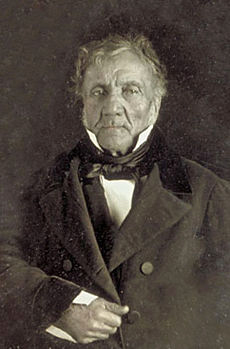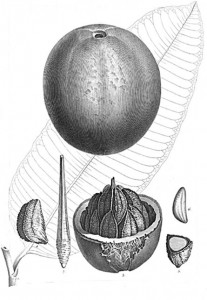The Organization of the Botanical World
Posted in Science on June 24 2013, by Scott Mori
Scott A. Mori is the Nathaniel Lord Britton Curator of Botany at the The New York Botanical Garden. His research interests are the ecology, classification, and conservation of tropical rain forest trees. His most recent book is Tropical Plant Collecting: From the Field to the Internet.

In our continuing discussion on botanical taxonomy, we now delve into the discovery of the Brazil nut and explain where it fits into the plant kingdom. But don’t be mistaken—when I say “discovery,” I am referring to the scientific naming and classification of the species rather than the first physical discovery of the plant by humans. Nearly all economic plants were discovered and given common names long before scientists became aware of them.
As part of their travels to the New World (between 1799 and 1804), the German scientist Alexandre von Humboldt and the French botanist Aimé Bonpland traversed the Rio Orinoco, making natural history collections and observations along the way. At one point, they subsisted for three entire months on rancid chocolate and plain rice alone. Fortunately, these explorers came upon Brazil nut collectors, allowing them to feast on great quantities of Brazil nut seeds. They were also impressed by the magnificent tree itself, and so interested in obtaining its flowers that Humboldt offered an ounce of gold to any one of the collectors who could find and retrieve them—an impossible task, as fruiting Brazil nut trees were not in flower.
Nevertheless, the expedition made collections of the leaves and fruits, and Bonpland described the species as Bertholletia excelsa Bonpl. Although the authorship of this species is sometimes attributed to both Humboldt and Bonpland, it is clear that the latter is the author of the scientific description and name for this species. Bonpland dedicated the genus to Claude Louis Berthollet, a chemist who, along with Antoine Lavoisier, developed a system of modern chemical nomenclature.
Bonpland writes the following about Berthollet: “Je le dédie à l’illustre M. Berthollet, à l’on doit tant de découverts, et dont les travaux actuels promettent beacoup à la physiologie et à la chemie des végétaux.”
Translated: “I dedicate this species to the illustrious Mr. Berthollet, who has made many discoveries and whose works have contributed much to the understanding of the physiology and chemistry of plants.”

When a species of plant is named, it is also placed into the hierarchy of plant classification, which includes several different levels. I use the Brazil nut as an example of how that species fits into the hierarchy of classification. Each of these levels is called a taxon (plural = taxa) as follows:
Plantae = the name of the plant kingdom (sometimes called Phylum).
Magnoliophyta = the name of the division (angiosperms or flowering plants, ends in “-phyta”).
Ericales = the name of the order (always ends in “-ales”).
Lecythidaceae = the name of the family (family name is formed by adding “-aceae” to the name of the first genus published in the family, in this case Lecythis).
Bertholletia = the name of the genus (plural = genera; the genus is always italicized).
Bertholletia excelsa = the name of the species (the species name is a binomial that includes both the genus name and species epithet, Note that scientific names at the generic rank and below are italicized. In scientific papers the author or authors of the name are added the first time the name appears in the paper, but the authors are not in italics.).

The following lower ranks are sometimes used to recognize less significant morphological differences: subspecies (abbreviated as either subsp. or ssp.) refer to populations of a species that usually display one or a few minor morphological differences in combination with geographical separation from other populations. Variety (abbreviated as var.) refers to minor morphological differences between populations within the same geographical area. Forms are also described, but they are used primarily for recognizing variation in cultivated plants.
Thus, knowing the scientific name of a species reveals the hierarchical relationships of a plant within the plant kingdom. That name also opens the door to the plethora of information that has been gathered since the time of Linnaeus. As an example, you can Google Bertholletia excelsa for additional information about this spectacular plant.

